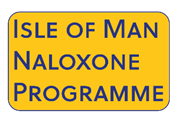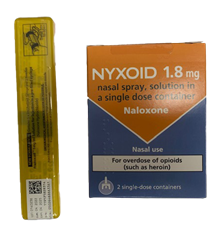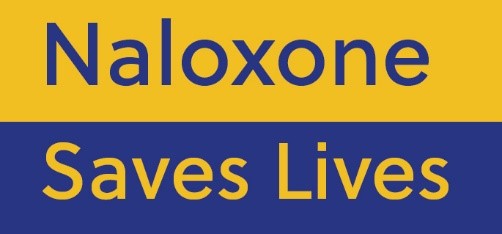Isle of Man Take-Home Naloxone Programme
Quicklinks
Safety alert
A National Patient Safety Alert has been issued by the Office for Health Improvement and Disparities (OHID) for Nitazenes, a group of potent synthetic opioids. This follows an increased number of overdoses, with some deaths, in the UK. There is no evidence of Nitazenes in the Isle of Man to date, but Public Health is warning people in the Island who may come into contact with the drug.
The advice is to look out for each other and if you think someone has overdosed, call 999 immediately and administer Naloxone if you have it.
The Isle of Man Take-Home Naloxone programme aims to raise awareness and reduce the effects/harms of opioid overdose.

Drug-related deaths have been rising in the Isle of Man in past years, and opioids have played a significant role. There were 99 drug related deaths from 2006 to 2021 based on year of death registration.
Many people who die of an opioid overdose are not alone at the time of death and when somebody is experiencing an overdose, they are incapable of calling for help or administering naloxone to themselves.
The Take-Home Naloxone Programme aims to make naloxone more readily available in places where overdoses might occur, by training potential bystanders in overdose awareness, and naloxone administration and also supplying them with their own naloxone kit to use in an emergency.
Get a kit, Carry a kit, Save a life.
About Naloxone
 Naloxone is a life-saving medication that, when given in time, can reverse an opioid/opiate overdose and save someone's life in almost every case. It works on substances including, heroin, fentanyl and prescription opioid medications by blocking the effects of opioids on the brain and restoring breathing within 2 to 3 minutes. YouTube video on how Naloxone works.
Naloxone is a life-saving medication that, when given in time, can reverse an opioid/opiate overdose and save someone's life in almost every case. It works on substances including, heroin, fentanyl and prescription opioid medications by blocking the effects of opioids on the brain and restoring breathing within 2 to 3 minutes. YouTube video on how Naloxone works.
Naloxone won't harm someone if they are overdosing on drugs other than opioids, so it's always best to use it if someone is experiencing a suspected overdose. It also has no effects on someone who has no opioids in their system, and it is safe for practically anyone to use. There are two forms of naloxone commonly used: Prenoxad® prefilled syringe for intramuscular injection (2mg/2ml) and Nyxoid® intranasal spray (1.8mg/0.1ml).
Naloxone is not just for illicit drug use, it’s for opioid prescription use as well.
Who can get Naloxone
Naloxone is available to anyone in the Isle of Man who is at risk or knows someone at risk of an opioid overdose. This can be:
- anyone using illicit or prescription opioids
- a family member or friend of someone at risk of opioid overdose
- workers who may come into contact with someone experiencing an opioid overdose
Where you can get Naloxone on the Isle of Man
Naloxone is available from the following locations:
- Manx Care Drug and Alcohol Team
- Motiv8 Addiction Services - call the Freephone 08081624627 for more information
- Monthly drop-in events – see Isle of Man Naloxone Facebook or Isle of Man Naloxone Instagram for details
- Accident and Emergency (if admitted due to an opioid overdose)
- Community Mental Health Service for Adults (CMHSA) /Crisis Response Home Treatment Team (CRHTT)
- Manannan Court if you are an inpatient ready for discharge, and are at risk of an opioid overdose
- Paramedics when they attend the scene of an opioid overdose
- Emergency Department if the individual has been admitted to hospital following an overdose
- IoM Prison – Prisoners at risk of opioid overdose will be trained in Prison and supplied with a naloxone kit upon discharge
What happens when you receive a Naloxone kit
When you receive a Naloxone kit, you will also get training on how to administer it.
Watch the video below on how to administer Naloxone:
The training will include the following information:
- The signs and symptoms of an overdose
- The actions that should not be attempted on a person suffering a suspected overdose
- Always call 999 and ask for an ambulance
- The principles of basic life support, cardiopulmonary resuscitation and the recovery position
- Naloxone will only work on opiate based drugs, such as, heroin or methadone
- The effects will only last for around 20-30 minutes
- Naloxone does not remove opiates from the body and there is a risk that somebody could go back into an overdose state
- One dose of naloxone should be administered every 2 to 3 minutes if there is no response from the casualty
- It is important someone does not take more drugs to negate the effect of withdrawal brought on by naloxone
You should also remember to:
- Keep the pack sealed until needed. Never use a damaged or opened kit unless you are positive it contains naloxone
- Store in a cool, dry place, protected from light
- Return for a resupply when the expiry date on the product is reached
- Dispose of the pack properly
- Make sure people know where you keep your naloxone kit
How to respond to an opioid overdose (with or without Naloxone)
The signs of an opioid overdose include:
- Appearing asleep or unconscious
- Blue lips or skin
- Slow or shallow breathing
If you think someone may have overdosed, follow these steps:
- Step 1: Call their name. If they don’t wake up, poke them in the chest
- Step 2: If they don’t respond, dial 999 RIGHT AWAY and ask for an ambulance. The paramedics won’t call the police unless there is a death, a child at risk or the paramedics are threatened with violence
- Step 3: Tell the operator someone is unconscious and having trouble breathing. Give an accurate address
- Step 4: Make sure there is nothing stuck down their throat (like false teeth or vomit). If they stop breathing give mouth-to-mouth if you know how
- Step 5: Put the victim on their side in the recovery position. Video on how to put someone in the recovery position
- Step 6: Administer Naloxone if you have it. You cannot harm the person even if you aren’t sure what they have taken
- Step 7: Stay with the victim until the ambulance arrives. If you know, tell the paramedic exactly what the person has taken
Be aware
The effects of Naloxone only last about 20 to 30 minutes, so getting the victim to a hospital right away is crucial so that they don’t slip back in to overdose.
The victim may have withdrawal symptoms when they wake up, but these will be short lived and they should not use further substances to try and alleviate symptoms.
Things to avoid
- DON’T inject them with anything other than Naloxone or give them anything to eat or drink. It won’t help and it might kill them
- DON’T drag them outside or leave them in a phone box. Until the ambulance arrives, their life is in your hands
- DON’T splash them with cold water or put them in a bath. They may go into shock or drown
Overdose prevention
- Do go easy after a break – Heroin tolerance drops rapidly during a break in use. You are 34 times more likely to overdose in the first 2 weeks after a prison sentence. What would have been a mild hit 2 months ago might be enough to kill you today. If you haven’t used heroin for some time it’s better to smoke the drug. If you are determined to inject, use the same amount you used on your very first time
- Do taste the hit – Inject a little of the drug and ‘taste’ the effects before emptying the rest of the barrel
- Do make a pact – Never inject on your own. Talk to the people you inject with about what you would do if one of you were to overdose. Make sure everybody knows what to do in an emergency and make a pact to help each other if something goes wrong
- Don't mix your drugs – Mixing any other drug (especially depressants like alcohol, methadone and benzo's) increases the risk of overdose
FAQs
Side effects to using Naloxone
Naloxone can cause side effects such as:
- Feeling sick
- Being sick, dizziness, headache, fast heartbeat, increased blood pressure
- Sweating, tremor, decreased or irregular heart rhythm, diarrhoea, faster or deeper breathing
- Fits
- Allergic reaction
Symptoms of withdrawal are commonly experienced when administering naloxone in opioid overdose. The individual should be reassured that these effects will be short lived as naloxone will begin to wear off after 20-30 minutes. They should be strongly advised against the use of additional substances, which will increase the risk of further overdose.
Misussing Naloxone
 Legally, anyone can administer naloxone injection and nasal naloxone but only in the instance of a life-saving emergency.
Legally, anyone can administer naloxone injection and nasal naloxone but only in the instance of a life-saving emergency.
Naloxone has no psychoactive properties and has no intoxicating effects or dependence potential, so it is always best to use it if someone is experiencing a suspected overdose, even if you are unsure of what substance is causing the overdose.
You cannot overdose on Naloxone.
If you would like to find out more about how you can get involved the Isle of Man Take-Home Naloxone Programme contact Public Health on +44 1624 642639.
Updated: July 2023


